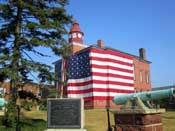Manassas - Virginia Historic Site

BATTLE OF MANASSAS JUNCTION (BULL RUN)
Although several states had seceded from the Union by the Spring of 1861 some people in the North thought that any conflict between the two sides would be short and inconsequential. So convinced that any battle between Union troops and the undersupplied rebels would be free entertainment, many families came out to Manassas Junction near Washington, D.C. with picnic baskets and blankets to watch the show.
On July 21, 1861 Union General Irwin McDowell faced off with Confederate General P.T. Beauregard in what President Lincoln expected to be a relatively easy victory for the North. Possibly due to a lack of strategic planning than anything else, McDowell was surprised by the strength and fighting spirit of the rebels, who easily routed his troops in the first major battle of the Civil War. The two sides suffered a total of 2,900 casualties that day and it was an embarrassing defeat for the North. On June 25, 1862 the Second Battle of Manassas was fought, with the Union faring only slightly better in a much bloodier engagement which produced 22,180 casualties.
President Lincoln was now convinced that the secessionists were prepared to fight a long and bloody conflict to gain their independence. The conflagration which many people in the northern states thought would be merely a skirmish would rage for almost four more years and claim roughly 600,000 casualties.
Today the site is a National Battlefield Park with a visitor center which provides a film on the battle, a museum with artifacts and maps of walking trails through the park.
